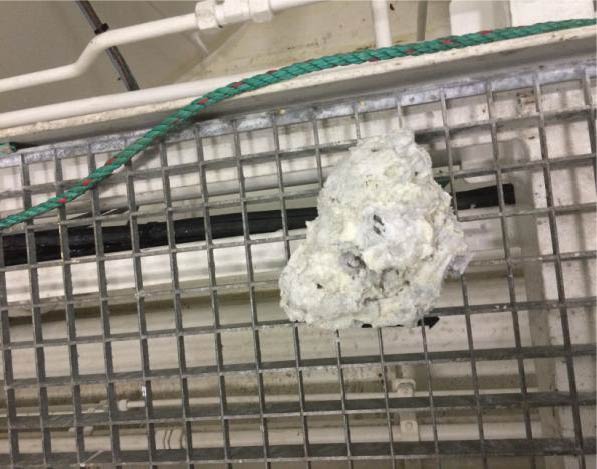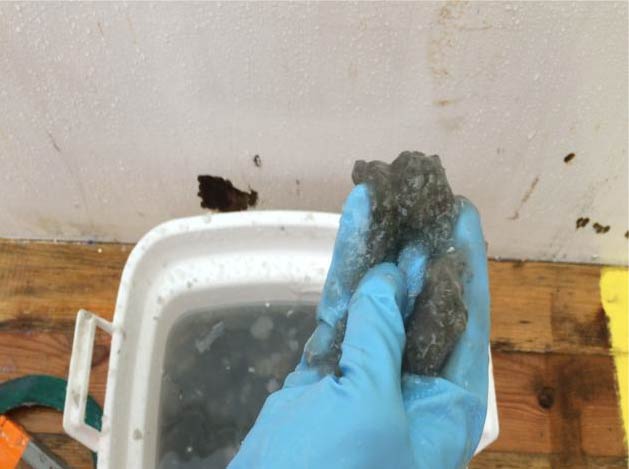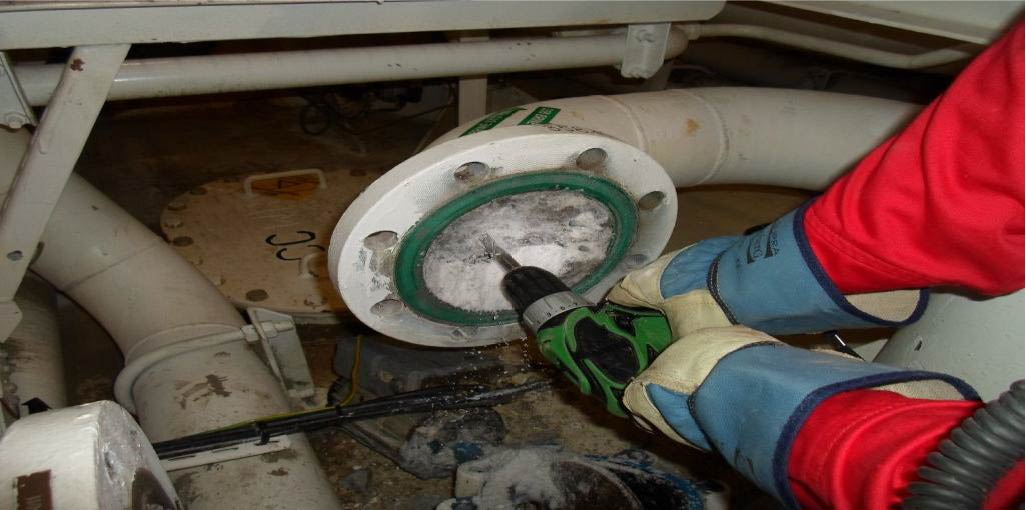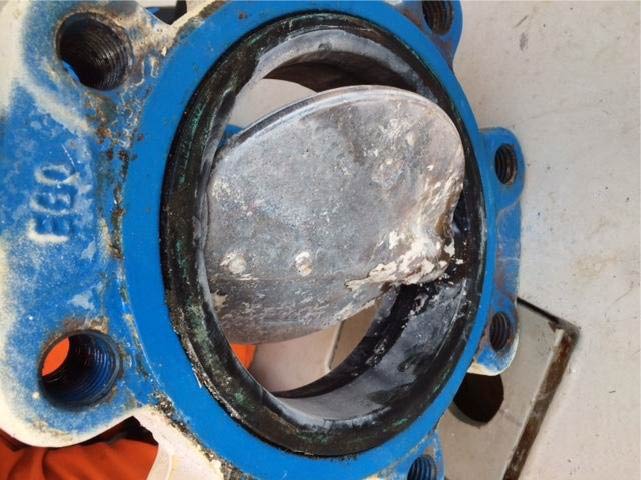Cargo contamination causing LTIs during clean-up
A member has reported an incident in which there was contamination of liquid cargo on an offshore support vessel. The incident led to a week-long cleaning operation in which a number of crew became ill and had to take time off work to recover. The incident occurred during loading of 50 cubic metres of calcium chloride brine. As loading started, it was swiftly noticed that no cargo was being received into the tank. The manual valves in the brine system were checked, and it was verified that they were open as they should be. When the loading line was connected to another (amidships) manifold to attempt loading from there into the tanks, the same situation was experienced and no cargo received into either tank. The suspicion arose that the line might be blocked, and it was decided that the loading had to be stopped. To assess the problem, dismantling of the line was started. When the lines were opened it was found that the calcium chloride brine had turned into a crystallized white mass, in some places completely packed in, and further into the line system, at the aft crossover line, a gel-like mass, blue-greyish in colour, was discovered, which in a tray formed a thicker mass setting to the bottom with a more fluid version on the top.




The subsequent unexpected task of dismantling, cleaning and reassembling the pipes took over one week, involving work from both vessel crew and outside contractors. It had a negative but temporary impact on the health of some personnel involved. At the end of the cleaning period, some of the vessel personnel involved in the dismantling of the line system reported the following symptoms:
- Nausea;
- Fatigue;
- Respiratory problems – specifically, it was noticed that some persons were breathing strenuously, two of them even during normal speech while sitting down. Further, one of the individuals with prior light symptoms of asthma, though normally independent of his ‘inhaler’, subsequently reported that use of the ‘inhaler’ had become necessary during this period;
- Discoloured (darkened) urine;
- Kidney pain.
Four persons had to take sick leave resulting in lost time injury (LTI). It is anticipated that all the sick persons will make a full recovery, though some months off work were necessary in some cases.
Our member undertook a thorough investigation which noted the following:
- With regard to the clogging of the cargo system:
- The vessel was relatively new and this was only the third time the brine loading system had been in use;
- On the two previous occasions the cargo had been a silica product known as Sildrill;
- There were trace quantities of the silica product Sildrill left in the brine loading system after discharging the Sildrill;
- It was confirmed that the conditions found in the ship’s brine loading system formed near perfect conditions for a reaction between the trace quantities of Sildrill and the calcium chloride brine;
- The crystallisation in the pipe came about because of chemical changes when the brine came into contact with the silica product Sildrill. These chemical changes caused a gel or solid substance to form in the pipes.
The immediate causes of the clogging of the cargo system were found to be:
- Chemical changes arising from inappropriate mixing of trace quantities of previous Sildrill cargo with calcium chloride brine;
- There was a machine failure in that there was an erroneous indication of the valve in the aft crossover line being closed while it was 45% open – this led to the flow of cargo going into areas from which it would normally be blocked. This contributed to the clogging.
The root causes were found to be:
- Lack of experience and knowledge of this type of cargo – officers involved in the previous two loadings of the Sildrill were unfamiliar with what the substance actually was and had no prior experience in dealing with it; . Lack of familiarity with the chemical components of the two different types of cargoes: . Officers would not have been able to foresee the chemical reaction that occurred when Sildrill and calcium chloride brine came into contact with one another . To both officers and crew, the perception was that both cargoes were ‘some sort of brine’ and also both cargos were considered ‘harmless’;
- Inadequate or incorrect information supplied to the vessel: . They were informed by the company logistics department that the cargo was a ‘brine-like material’. Whilst instructions were given to wash the tanks and lines, there was no explicit emphasis on the importance of this washing, and, hence, the system was washed to ‘brine standard’ as per company procedures . As a result of this, trace quantities of Sildrill were left in the system; . Company procedures or standards for cleaning cargo pipework were not adequate.
- With regard to the subsequent ill-health of the crew involved in the clean-up operation:
- Chemical analysis by an independent third party of the blend of substances removed from the brine loading system revealed some presence of metals, of which the highest level was the metal Chromium;
- How this metal got into the pipe system was not confirmed (and confirmation was sought from the manufacturer of the pipes that it did not originate from the pipework itself), but notwithstanding that, this metal is a known irritant to the human respiratory system.
The root causes were found to be:
- There was a common understanding on the vessel regarding the ‘complete harmlessness of this cargo’, in spite of existing information in the Material Safety Data Sheets. As a result there was inadequate adherence to procedures: . Appropriate risk assessment did not take place, nor was there any toolbox talk before dismantling and cleaning operations started
- There was no Permit to Work (PTW) sought.
Our member took the following corrective actions:
- Improved communication/instruction programme – ensured vessel crew had better awareness regarding cargo properties;
- Made improvements to cargo system washing facilities;
- Made improvements to communications between vessel and logistics department.
Members may wish to refer to the following incident (search words: cargo, bulk):
Safety Event
Published: 22 October 2015
Download: IMCA SF 16/15
IMCA Safety Flashes
Submit a Report
IMCA Safety Flashes summarise key safety matters and incidents, allowing lessons to be more easily learnt for the benefit of all. The effectiveness of the IMCA Safety Flash system depends on Members sharing information and so avoiding repeat incidents. Please consider adding [email protected] to your internal distribution list for safety alerts or manually submitting information on incidents you consider may be relevant. All information is anonymised or sanitised, as appropriate.
IMCA’s store terms and conditions (https://www.imca-int.com/legal-notices/terms/) apply to all downloads from IMCA’s website, including this document.
IMCA makes every effort to ensure the accuracy and reliability of the data contained in the documents it publishes, but IMCA shall not be liable for any guidance and/or recommendation and/or statement herein contained. The information contained in this document does not fulfil or replace any individual’s or Member's legal, regulatory or other duties or obligations in respect of their operations. Individuals and Members remain solely responsible for the safe, lawful and proper conduct of their operations.
